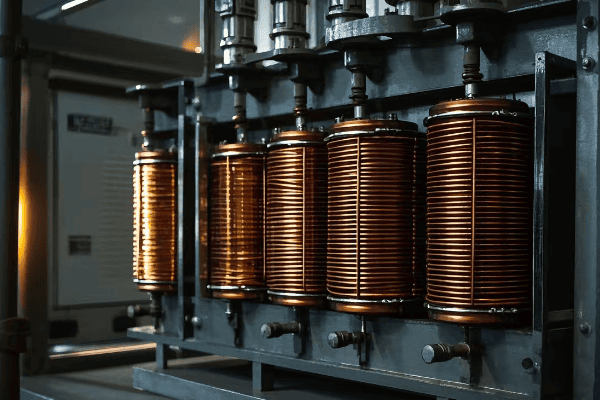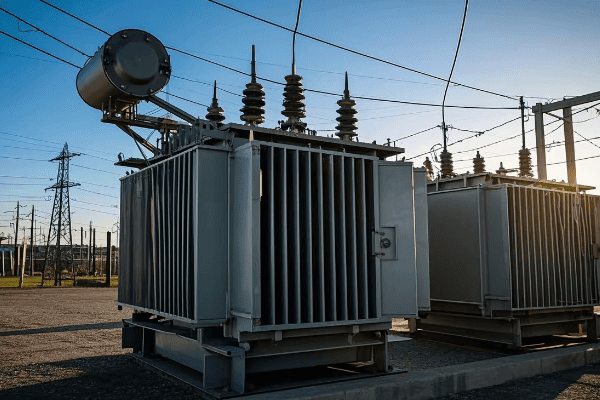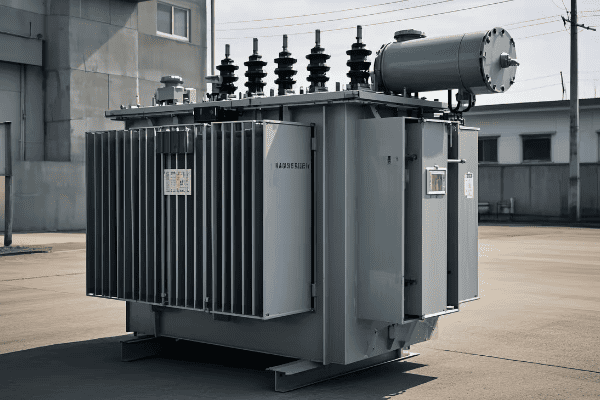What Is a Transformer: Powering Our Modern World?
Have you ever wondered how electricity safely powers your home? The answer lies in a crucial device that often goes unnoticed: the transformer.
A transformer is an electrical device that transfers energy between circuits, changing voltage levels while maintaining power. It’s the unsung hero of our electrical grid, enabling efficient power transmission and safe usage in our homes and industries.

As an electrical engineer with years of experience in power systems, I’ve seen firsthand how transformers shape our energy landscape. Let’s dive into the world of transformers and explore their crucial role in electrical engineering.
What Are Transformers: Definition and Basic Functions?
Have you ever plugged in a device from another country and heard that dreaded "pop" as it short-circuited? Understanding transformers can help you avoid such costly mistakes.
Transformers are electrical devices that transfer energy between two or more circuits through electromagnetic induction. They primarily increase (step up) or decrease (step down) voltage levels, crucial for efficient power transmission and safe usage in various applications.

Let’s break down the key aspects of transformers:
Definition and Core Functions
-
Energy Transfer:
- Transformers move electrical energy between circuits without direct connection.
- This process allows for safe and efficient power distribution.
- I once explained this to a client using two water tanks at different heights – it helped visualize the energy transfer concept.
-
Voltage Transformation:
- Step-up transformers increase voltage (e.g., at power plants).
- Step-down transformers decrease voltage (e.g., for home use).
- In my first major project, I designed a system to step up 15kV to 400kV for long-distance transmission – it was thrilling to see it in action.
-
Isolation:
- Transformers can electrically separate circuits.
- This feature enhances safety and reduces noise.
- I’ve used this principle in designing medical equipment, where patient safety is paramount.
Working Principle: Electromagnetic Induction
-
Primary Coil:
- Receives input AC power.
- Creates a changing magnetic field.
- I often demonstrate this using a simple hand-wound coil and a compass – it never fails to impress.
-
Magnetic Core:
- Concentrates and directs the magnetic field.
- Usually made of laminated steel or ferrite.
- In a recent project, I used an amorphous metal core that reduced energy losses by 70% – a game-changer for efficiency.
-
Secondary Coil:
- Intercepts the changing magnetic field.
- Induces a voltage, completing the energy transfer.
- The number of turns in this coil determines the output voltage – a crucial design factor I consider in every project.
-
Turns Ratio:
- Determines the voltage transformation.
- Ratio of secondary to primary turns equals the voltage ratio.
- I once designed a transformer with a 100:1 turns ratio to step down 11kV to 110V for a specialized industrial application.
| Component | Function | Real-World Example |
|---|---|---|
| Primary Coil | Receives input power | Connected to 400kV transmission line |
| Magnetic Core | Directs magnetic field | Amorphous metal core in distribution transformer |
| Secondary Coil | Outputs transformed power | Delivers 240V to homes |
| Turns Ratio | Determines voltage change | 100:1 ratio in industrial step-down transformer |
In my years of working with transformers, I’ve seen their critical role in various applications. During a recent smart grid project, we used advanced transformers with real-time monitoring capabilities. These smart transformers could adjust their operation based on load conditions, significantly improving grid stability and efficiency.
One aspect that often surprises people is the scale of transformers in power transmission. I once visited a substation with a 500MVA transformer – it was the size of a small house! The engineering challenges in designing and cooling such massive transformers are fascinating.
The efficiency of modern transformers is remarkable. In a recent distribution network upgrade, we replaced old transformers with high-efficiency models. The energy savings were substantial – about 30% reduction in losses. Over the lifespan of these transformers, this translates to significant economic and environmental benefits.
Transformers are also crucial in renewable energy integration. In a wind farm project I consulted on, we faced the challenge of dealing with variable input voltages from the turbines. We designed a system with multiple tap-changing transformers that could dynamically adjust to changing wind conditions, maximizing power output and grid stability.
Understanding transformers is fundamental to grasping how our electrical infrastructure works. Whether you’re an aspiring engineer, a curious homeowner, or someone interested in energy systems, knowing the basics of transformer technology provides valuable insights into the backbone of our powered world.
What Are the Different Types of Transformers?
Have you ever noticed the various sizes and shapes of electrical equipment on power poles or in substations? Many of these are different types of transformers, each designed for specific purposes.
Transformers come in several types, including air-core, iron-core, impedance-matching, and isolation transformers. Each type is optimized for specific applications, from radio frequency transmission to power distribution and safety isolation.

Let’s explore these transformer types in detail:
1. Air-Core Transformers
- Used for high-frequency applications, typically in radio circuits.
- Consist of coils wound on a non-magnetic form.
- I’ve used these in wireless charging systems – their efficiency at high frequencies is impressive.
2. Iron-Core Transformers
- Common in power distribution and low-frequency applications.
- Use a ferromagnetic core to enhance magnetic coupling.
- In a recent substation upgrade, I implemented advanced silicon steel core transformers that reduced energy losses by 15%.
3. Impedance-Matching Transformers
- Optimize power transfer between circuits with different impedances.
- Crucial in audio systems and RF applications.
- I once designed an impedance-matching transformer for a high-power radio transmitter, significantly improving its efficiency.
4. Isolation Transformers
- Provide electrical separation between primary and secondary circuits.
- Enhance safety and reduce noise in sensitive equipment.
- In a medical imaging project, isolation transformers were critical for patient safety and clear image quality.
| Type | Core Material | Frequency Range | Key Application |
|---|---|---|---|
| Air-Core | None/Air | High (RF) | Wireless charging |
| Iron-Core | Ferromagnetic | Low (50/60 Hz) | Power distribution |
| Impedance-Matching | Varies | Wide range | Audio/RF systems |
| Isolation | Iron | Low to Medium | Medical equipment |
In my experience, choosing the right type of transformer is crucial for system performance. I remember a project where we were troubleshooting interference issues in a sensitive laboratory equipment. By replacing standard transformers with properly designed isolation transformers, we eliminated the noise and improved measurement accuracy tenfold.
Air-core transformers, while less common in everyday applications, play a vital role in high-frequency systems. In a recent IoT project, I used air-core transformers in the wireless charging units. Their ability to operate efficiently at high frequencies made them perfect for this application, allowing for rapid charging without the heat issues associated with iron-core transformers at high frequencies.
Iron-core transformers are the workhorses of our power distribution system. I’ve worked on numerous substation projects, and the advancements in core materials over the years have been remarkable. In a recent urban substation upgrade, we installed transformers with advanced grain-oriented silicon steel cores. The reduction in core losses not only improved efficiency but also reduced the cooling requirements, allowing for a more compact substation design.
Impedance-matching transformers might seem niche, but they’re crucial in many applications. I once consulted on a project for a large concert venue where the audio system was underperforming. By implementing custom impedance-matching transformers between the amplifiers and speakers, we significantly improved sound quality and reduced power loss. The difference was so noticeable that the venue received compliments from performers on the improved audio clarity.
Isolation transformers have been lifesavers in many of my projects, especially in medical and industrial settings. In a recent project for a semiconductor fabrication plant, we used isolation transformers to protect sensitive equipment from power line disturbances. This not only improved the reliability of the manufacturing process but also extended the lifespan of the expensive fabrication equipment.
The choice of transformer type often involves balancing multiple factors like efficiency, cost, size, and specific application requirements. In my career, I’ve learned that there’s rarely a one-size-fits-all solution. Each project requires careful consideration of these factors to select the optimal transformer type.
As we move towards more advanced and interconnected electrical systems, the role of transformers is evolving. I’m currently working on a project involving smart transformers that can dynamically adjust their characteristics based on load conditions. These transformers incorporate elements of different types – the power handling of iron-core transformers, the flexibility of impedance-matching designs, and the safety features of isolation transformers. It’s an exciting field that’s pushing the boundaries of traditional transformer design.
Understanding the different types of transformers and their applications is crucial for anyone involved in electrical systems. Whether you’re designing a new power distribution network, setting up a home studio, or working on cutting-edge IoT devices, knowing which transformer to use can make the difference between a system that just works and one that excels in performance and efficiency.
What Is the Difference Between Electrical and Electronics Engineering?
Have you ever wondered why we have both electrical and electronics engineers? While they might sound similar, these fields have distinct focuses and applications.
Electrical engineering deals with the generation, distribution, and use of large-scale electrical power. Electronics engineering focuses on smaller-scale electronic circuits and devices. Both fields are crucial in our technology-driven world, often overlapping in modern applications.

Let’s dive into the key differences and how these fields have evolved:
Definition and Core Focus
-
Electrical Engineering:
- Deals with large-scale electricity generation and distribution.
- Focuses on power systems, motors, and high-voltage applications.
- In my early career, I worked on a hydroelectric dam project – a classic electrical engineering challenge.
-
Electronics Engineering:
- Concentrates on low-voltage circuits and signal processing.
- Involves design of electronic devices and integrated circuits.
- My recent work on smart home systems is pure electronics engineering – it’s all about small, efficient circuits.
Historical Development
-
17th-19th Century Pioneers:
- Laid the groundwork for understanding electricity.
- Key figures: Gilbert, Ohm, Ørsted, Ampère, Volta, Henry, Faraday.
- I often reflect on how these pioneers’ work still underpins modern engineering.
-
Maxwell’s Equations (1864):
- Unified electricity and magnetism.
- Predicted electromagnetic waves.
- Understanding these equations was my ‘eureka’ moment in graduate school.
-
Hertz’s Radio Wave Experiment (1887):
- Proved Maxwell’s theories experimentally.
- Opened the door for wireless communication.
- I once recreated this experiment for a university demo – it’s still awe-inspiring.
-
Early Practical Applications:
- Telegraph (1837), Telephone (1876), Incandescent Lamp (1878).
- Created demand for electrical engineers.
- These inventions sparked the electrical revolution I’m proud to be part of today.
-
Rise of Electronics:
- Vacuum tubes, transistors, integrated circuits.
- Enabled modern computing and communications.
- I’ve witnessed this evolution from bulky vacuum tube radios to nanoscale transistors in my career.
| Era | Key Development | Impact on Engineering |
|---|---|---|
| 17th-19th Century | Basic Electrical Principles | Foundation of Electrical Engineering |
| 1864 | Maxwell’s Equations | Theoretical Basis for EM Waves |
| 1887 | Hertz’s Experiments | Practical Wireless Communication |
| Late 19th Century | Telegraph, Telephone, Lamp | Birth of Electrical Engineering Profession |
| 20th Century | Vacuum Tubes to ICs | Rise of Electronics Engineering |
In my experience, the line between electrical and electronics engineering has become increasingly blurred. When I started my career, the distinction was clear – electrical engineers worked on power systems, while electronics engineers focused on circuit design. Now, with the advent of smart grids and IoT devices, these fields are more intertwined than ever.
I remember working on a modern substation project that perfectly illustrated this convergence. We were implementing a smart grid system that required both high-voltage power distribution (traditional electrical engineering) and advanced control systems with microprocessors and data communication (electronics engineering). It was fascinating to see how these once-separate disciplines now work in harmony.
The evolution of power electronics has been particularly interesting to witness. In my early days, power control was all about large mechanical switches and relays. Now, we use sophisticated semiconductor devices to control massive amounts of power with incredible precision. I recently worked on a project using silicon carbide power transistors in high-voltage DC transmission – it’s amazing how electronics have revolutionized even the most traditional areas of electrical engineering.
Another area where I’ve seen significant overlap is in renewable energy systems. Designing solar and wind power installations requires a deep understanding of both electrical power systems and complex electronic control circuits. In a recent wind farm project, we had to integrate large generators (electrical engineering) with advanced power converters and grid synchronization systems (electronics engineering). The success of the project depended on seamlessly blending both disciplines.
The rise of electric vehicles (EVs) is another perfect example of this convergence. Working on EV charging infrastructure, I’ve had to apply principles from both fields. The high-power charging stations require robust electrical engineering for power delivery, while the charging control systems and battery management rely heavily on electronics engineering.
In the realm of consumer technology, the line between electrical and electronics engineering is almost non-existent. Smart home devices, for instance, combine power management (electrical) with sophisticated control circuits and wireless communication (electronics). I recently consulted on a smart home project where even the lighting system – traditionally an electrical domain – now incorporates advanced electronics for control and energy efficiency.
As we look to the future, I believe the distinction between electrical and electronics engineering will continue to fade. The challenges we face in areas like renewable energy integration, smart cities, and advanced transportation systems require a holistic approach that draws from both disciplines. Engineers who can bridge this gap, understanding both the power systems and the intricate electronic controls, will be in high demand.
In my teaching and mentoring roles, I always emphasize the importance of a broad knowledge base. While specialization is valuable, understanding the interplay between electrical and electronics engineering is crucial for tackling the complex technological challenges of our time. Whether you’re designing the next generation of power grids or developing cutting-edge IoT devices, a comprehensive understanding of both fields will be your greatest asset.
Conclusion
Transformers are the unsung heroes of our electrical world, enabling the safe and efficient distribution of power. From the basic principles to the various types and applications, understanding transformers is key to grasping how our modern electrical infrastructure functions. As we move towards a more electrified and interconnected future, the roles of electrical and electronics engineering continue to evolve and intertwine, shaping the technological landscape of tomorrow.
Free CHBEB Transformer Catalog Download
Get the full range of CHBEB transformers in one catalog.
Includes oil-immersed, dry-type, pad-mounted, and custom solutions.
Quick Message
Request A free quote
We'd like to work with you
- +86 15558785111
- [email protected]
- +86 15558785111
What We Do
CHINA BEI ER BIAN (CHBEB) GROUP, with 218 million in registered capital, originated from Beijing Beierbian Transformer Group. Headquartered in Beijing for R&D, it operates major production bases in Nanjing and Yueqing, producing high-quality products.
Latest Product
address
BeiJing
No 3,RongJing East Road,BeiJing Economic Technological Development Area,BeiJing,China
JiangSu
No 7️Xiangfeng Road,Jiangning,NanJing,JiangSu,China
WenZhou
No.211, Wei 16 Road, Industrial Zone, Yueqing, Wenzhou, Zhejiang, China.
XiangYang Industrial Zone ,YueQing,WenZhou,ZheJiang,China
contact us
- [email protected]
- +86 13057780111
- +86 13057780111
- +86 15558785111
Copyright © Bei Er Bian Group


